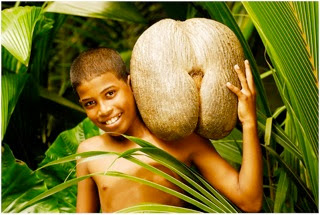It’s the time of year that anyone situated north of the Tropic of Capricorn starts to dream of warm, sunny beaches. Dream no more--seven degrees south of the equator, 1000 kilometers off the coast of Kenya is a group of mountainous islands that rise up out of the Indian Ocean. Neither volcanic nor coral atolls, the Seychelles are made entirely of granite, fragments of a continent that united India and Africa many millennia ago.
Uninhabited until well into the 18th century, they served as a hideout for pirates and an isolated ecosystem that boasts over 50 species of flora and fauna unique to the archipelago, including a giant tortoise identical to those on the Galapagos, and the Coco de mer, whose giant, voluptuous coconuts are an eerie replica of the female anatomy. So much is this symbol of the islands replicated on coffee cups, bars of soap, tea towels, and signs everywhere that it served as a constant (and erotic) reminder that we were a long ways from the conservative Middle East.
If the landscape reminds one of islands off the coast of Maine (that is, if giant palms grew among the pines on New England’s granite shores and the temperature never got below 70 F), the culture is decidedly pan-Caribbean. The friendly locals speak a French-based Creole and serve up a mean filet de bourgeois, but in a testimony to the cultural mélange that comprises these islands, the driving is on the left and the barristers wear wigs, while the currency is the Seychelles rupee. We especially enjoyed the accepted phonetic spelling of French words (Keptin Lekip is the spelling for Team Captain—capitaine de l’equipe).
All in all, it’s a tropical paradise with a good tourist infrastructure and direct flights from Europe, the Middle East and points east. With the highest per capita income in Africa, it wistfully reminds us of what Haiti could have been. While we were warned to never leave anything visible in our car, we found it to be a safe and friendly environment, offering exquisite beaches, and mountainous hiking trails through rain forests.
Mahe is the largest island, with the international airport located about a 20 minute drive from Victoria, billed as the world’s smallest capital city. While Mahe is the largest and most populous of the islands, it’s important to add a little perspective. Downtown Victoria recently added a second traffic light,(that is, the second in the country) and we did get stuck in a 7 car tailback on the “highway” out of Victoria which cost us a good 3 minutes one afternoon.
On the second day of our stay we decided it was time to leave city life behind, and take the hairpin-laced Beau Vallon road across to the west side of the island. Heading southward down west coast, you will find the paved road ends at La Scala Restaurant. Go a bit further along the winding road (hopefully you rented a 4WD at the airport—most are) and find a small parking lot. Drop your car here and embark on a 3 km trek that alternates between virgin rainforest and exposed granite boulders with stunning views of the sea and coastline. The hike (good shoes recommended) reminded us of the Cinqueterre on the Italian coast, thanks to the rugged mountains running into the sea, but with wild papayas and pineapples replacing the Italian grapevines and olive stands.
At the end of the walk, your prize awaits. Anse Major is a gloriously secluded white sand beach, surrounded by huge boulders and rocky shoreline in both directions. Although it’s marked on most maps of Mahe, few bother to make the trek, and the rocks make it inaccessible to boaters. The day we visited, we shared the beach with a French family for part of our visit, but we enjoyed the end of the afternoon alone, taking in a sunset that matched the color of the bottle of Cotes du Rhone rosé we had lugged with us for just this moment. As if the perfect beach was not enough, there was plenty of shade from the Takamaka trees that bordered it, and the snorkeling was excellent, with a coral reef that started a few meters out. Oh, and one other thing. The last time we had been to an equatorial shore was in Costa Rica, where a similar hike landed us, hot and tired, on an equally deserted beach, but with an ocean that was the temperature of a hot bath. Not so at Anse Major—the ocean was cool and refreshing, but not too cold. Perfection once again.
How could you cap off a day like that? No problem. Head back to the paved road and drive less than a kilometer to Le Corsair, where white tablecloths and smooth jazz are waiting to sooth your tired muscles. Given its name and location in a half-timbered faux Norman farmhouse, who would guess it would be high-end Italian? Our red snapper and lobster pasta were magnificent, and the wine list looks like a 10 page tour of Italy, with wines from every region up to and including a fine Brunello di Montalcino. The owner, from Rome, does a good business—it wasn’t till we got to the airport a few days later and noticed the flight arriving from Rome Fumicino that we understood why he had to keep his standards up.


No comments:
Post a Comment